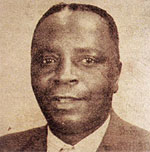During the 1920s, the South African Native National Congress (SANNC) - which changed its name to the African National Congress (ANC) in 1923 - did not accomplish much to improve the lives of black South Africans. Short of funds and poorly organised, it was overshadowed by the more dynamic Industrial and Commercial Workers Union (ICU), founded in Cape Town in 1919. Established by Clements Kadalie, who was originally from Nyasaland (now Malawi), the ICU started out as a trade union for the Black and Coloured dockworkers of Cape Town.
However, the ICU soon developed into a more general organisation, including in its membership skilled as well as unskilled workers from industry and the agricultural sector. Unlike the SANNC, the ICU did not officially petition the authorities, but adopted a more active approach with a view to obtaining better working conditions and higher wages for its members. As a result, its membership increased rapidly - mainly because the ICU held out hope for immediate change within the existing socio-economic system. The trade union movement spread to other urban areas, such as Natal, where it found an effective provincial secretary in George Champion. Soon ICU branches were opened throughout South Africa, and in 1925 the union moved its headquarters to Johannesburg.
By this time, however, the ICU was torn by dissension between its modern and radical wings - the latter consisting largely of Communist Party members. Questions also arose about the misappropriation of funds and the autocratic powers assumed by Kadalie and other ICU officials. In 1926 Kadalie expelled Communist Party members from ICU membership (official document released by the SACP after the expulsion).
 Clements Kadalie
Clements Kadalie
A new membership drive into rural areas of Natal, Transvaal, and the Orange Free State later in the same year met with considerable success, as the ICU shifted its focus from trade unionism to a more militant nationalism. A number of Swazi chiefs in the Nelspruit area, for example, went so far as to lead thousands of their followers into becoming members. 'Redemption has come and that is the IC,' rejoiced one chief. The ICU was also widely perceived as the organisation that stood up for Blacks against injustice. 'I see you' was often the way in which the name was interpreted. According to one white official, the letters ICU meant, 'I see you when you do not protect the Bantu.'
At its peak from 1927-1928 the ICU claimed more than 150 000 members. The majority of members were Black, but there were a few thousand Coloured members and some White members. But, the ICU as an organisation largely failed to provide effective activist leadership. It demanded a redistribution of economic and political power, but had no clear idea of how to achieve it. Too often it equated protest with pressure, and growing membership with increasing success. There was no consistent strategy. Rural members, isolated and poor, could only participate in local actions. Vague promises of land repossession and liberation came and went.
The ICU leaders could not mobilize their members for large-scale action. Isolated incidents such as livestock theft, work stoppages and property destruction were not effective and only succeeded to foment White anger. Considerable energy and money were expended to protect farm labourers, and although some small victories were registered, they were at the expense of consolidating and organising the workforce in the urban areas where the potential for success was greater. The ICU failed to promote strike action where it was clearly warranted, and when spontaneous strikes did occur on the Witwatersrand and in Durban in 1927, the organisation was unable to lend support.
In addition, when the ICU was first formed its principals were influenced by Garveyism, but that had changed over time (read more). Therefore, the ICU lost many of its supporters who were Christian converts or followers of Black Nationalist leader Marcus Garvey?s back-to-Africa movement.
Consequently, the organisation lost considerable credibility, which, despite its militant rhetoric, it never really recovered from. The leaders had not developed organically from the working class and although they were by no means affluent, they represented a trade union aristocracy. More fundamental problems pertained to the fact that many workers were migrants and therefore not totally committed to the urban and industrial milieu. Compared to today, only a fraction of the total black population was absorbed in the small industrial workforce.
In due course two factions developed within the ICU. There were those who supported more militant action, and those who advocated moderation. This, together with financial problems, was largely responsible for the gradual decline of the ICU. After Kadalie resigned in January 1929 and Natal banished Champion for three years in 1930, the ICU disintegrated and died out in the early 1930s. (article: The decline and fall of the ICU - A case of Self-Destruction?)
Nonetheless, even though the ICU disintegrated, it occupies an important place in the history of Black labour. Not only was it the first black trade union movement, but it also helped to make blacks more aware of their exploitation. In addition, it cut across traditional loyalties in its attempt to unite black people as workers.
The decline and disappearance of the ICU did not mark the end of the organised black trade union movement or joint workers' action in industry, and various black trade unions followed in its wake. A contributory factor was the introduction of a Wage Board, to which organised labour could make representations on matters concerning wages and working conditions. In the years that followed, strikes and boycotts occurred frequently. One such example was an anti-pass campaign in Durban in 1930, during which the Durban leader of the Communist Party of South Africa, Johannes Nkosi, was killed in a skirmish with the police. In the same year there was also a general strike of railway and harbour workers in East London.